Anyone who wanted to go to the National Riding Hall in the 1880s did not have to look for it on Kerepesi Road, but behind the National Museum, on the plot at 8 Pollack Mihály Square. The building of the riding hall, built between 1857 and 1858, was designed by Miklós Ybl. It is no accident that it operated here, because until the construction of the museum, the National Riding School operated on the northern corner of its plot.
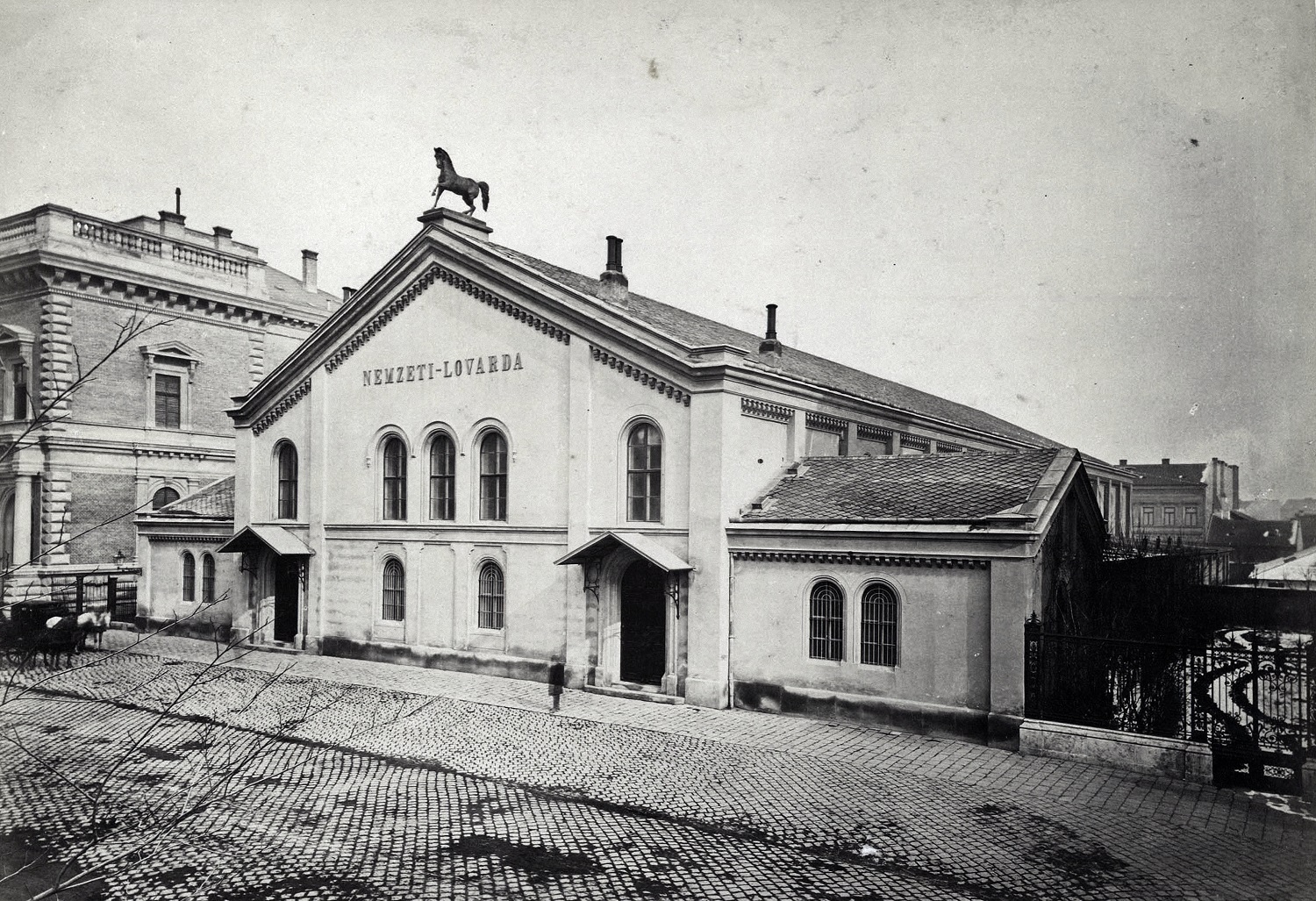
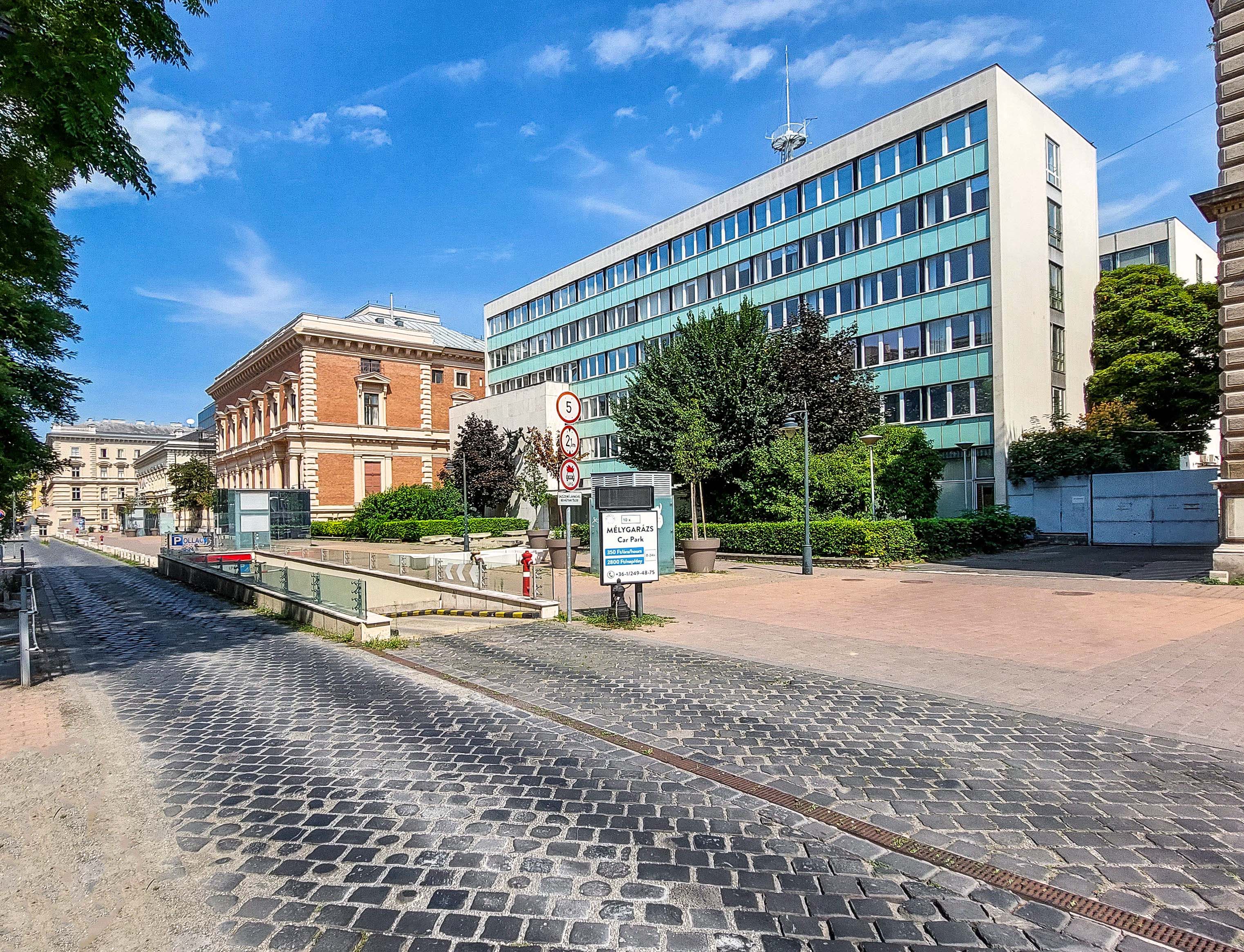
Behind the National Museum, at 8 Pollack Mihály Square, stood the building of the National Riding Hall, which was recorded by György Klösz between 1880 and 1890. The office building of the Hungarian Radio has been in its place since 1969 (Photo: Fortepan/Budapest Archives, No.: HU.BFL.XV.19.d.1.05.015; Balázs Both/pestbuda.hu)
After its completion, the riding hall also had a shooting range, and a salon on the first floor in accordance with the needs of the company. The top of the facade of the riding hall was decorated with a horse statue made by Anton Fernkorn, but its building was rebuilt and expanded in 1889, and then after World War II, it was demolished to make a larger garden for the Esterházy Palace, which was built in 1871 according to the plans of Antal Baumgarten. It was intended to be the residence of the Heads of State.
However, history has intervened: in 1950, the Hungarian Radio took possession of the building, together with an office building built on the site of the riding hall in 1966-1969, which was used by the institution until its recent relocation. The real estate complex was received by the Pázmány Péter Catholic University last year.
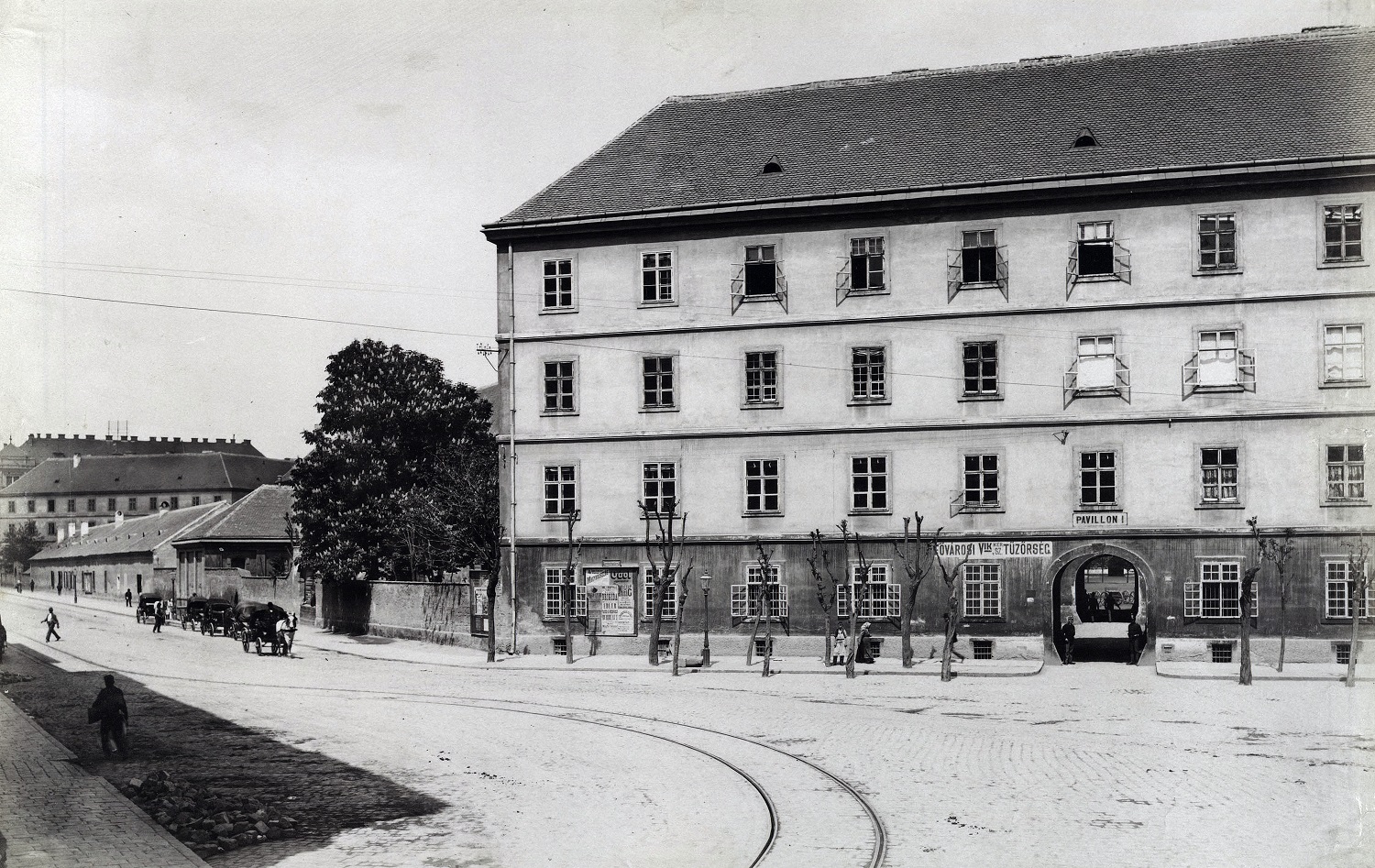
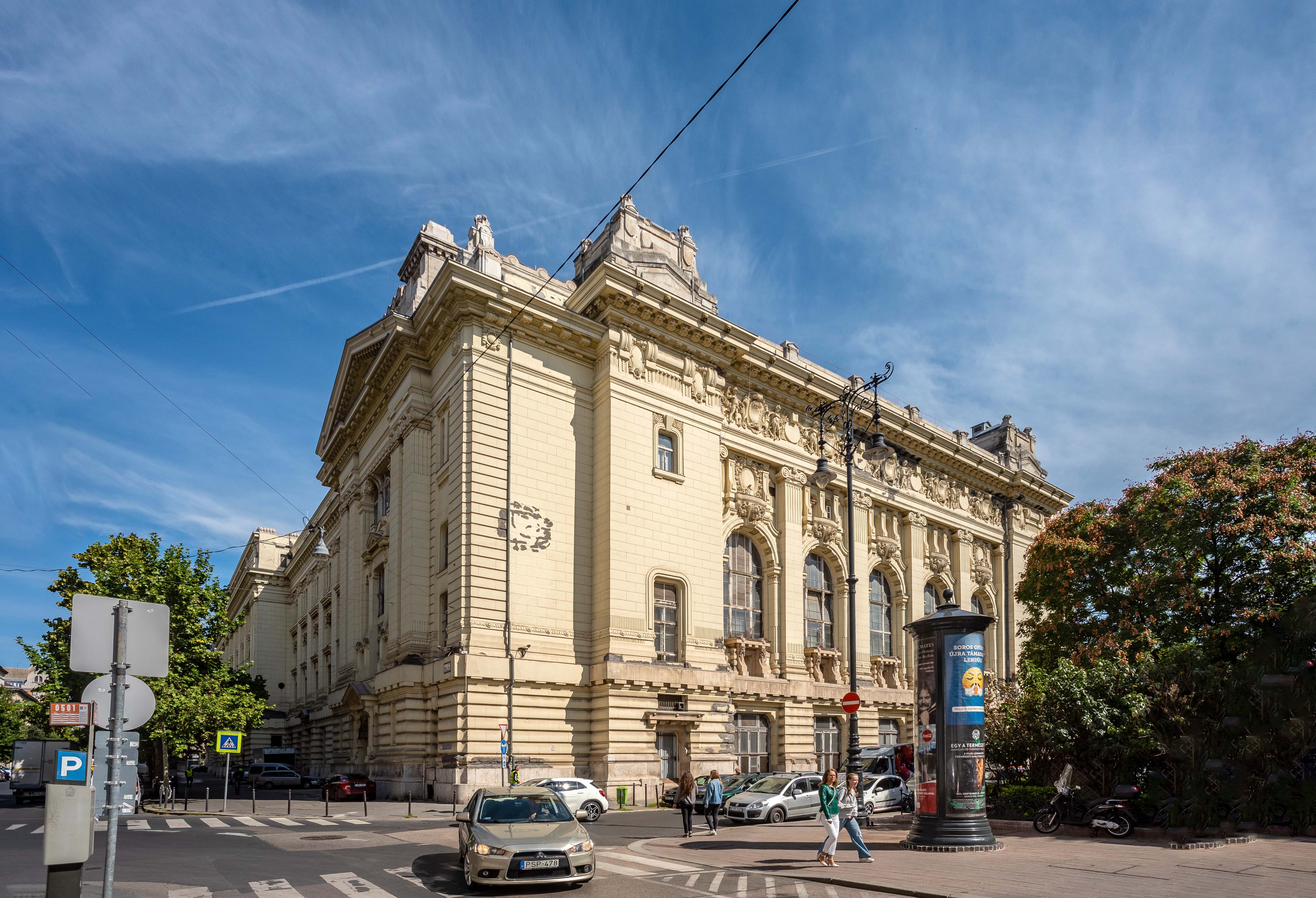
György Klösz's 1896 photograph shows the gigantic New Building, which once occupied all of today's Szabadság Square and the surrounding streets. Today, one of the wings is replaced by the Stock Exchange Palace (Photo: Fortepan/Budapest Archives, No.: HU.BFL.XV.19.d.1.08.050; Balázs Both/pestbuda.hu)
Today's Szabadság Square was occupied from 1786 to 1897 by the huge New Building (Neugebäude), which was ordered to be built by King Joseph II. The building, intended for a hospital of the poor and military wounded, became known as a barracks and a prison, and of course as the place for the execution of Prime Minister Lajos Batthyány on 6 October 1849.
Over time, towards the end of the 19th century, the huge building became depressing not only because of its past, but also because of its size: it increasingly hindered the city’s development. The Parliament was built nearby, so they finally decided to demolish it in 1894, which started in October 1897, and half a year later there was only a huge empty area left, on which the Szabadság Square was established. However, in 1896, György Klösz photographed the New Building, which had been living its last months, in front of which Nádor Street stretches to the left, and in the background the roof of the Kossuth Square Palace of the Ministry of Agriculture can be seen.
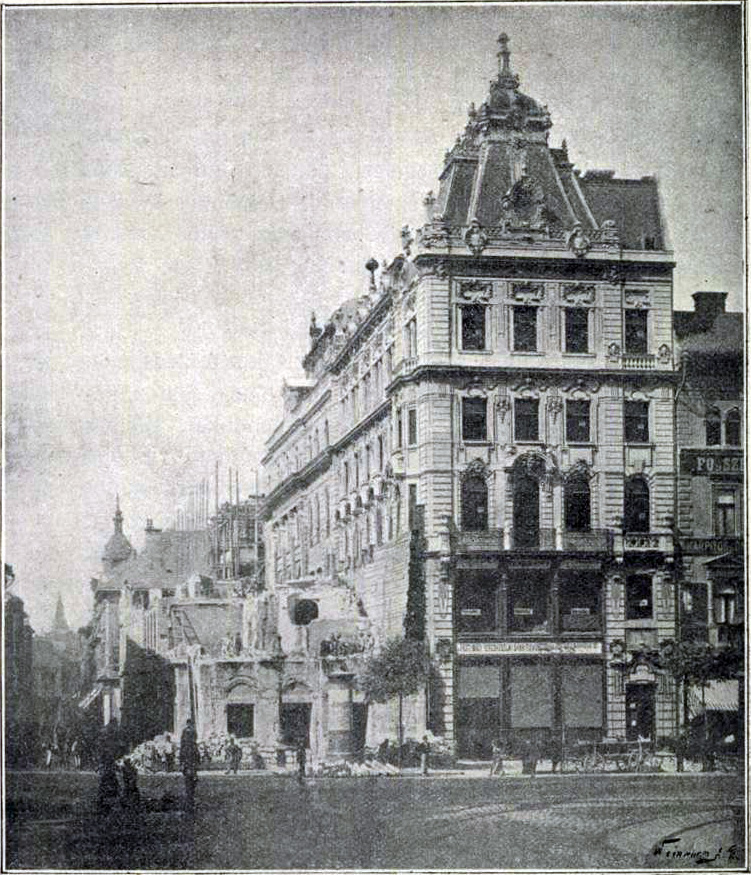
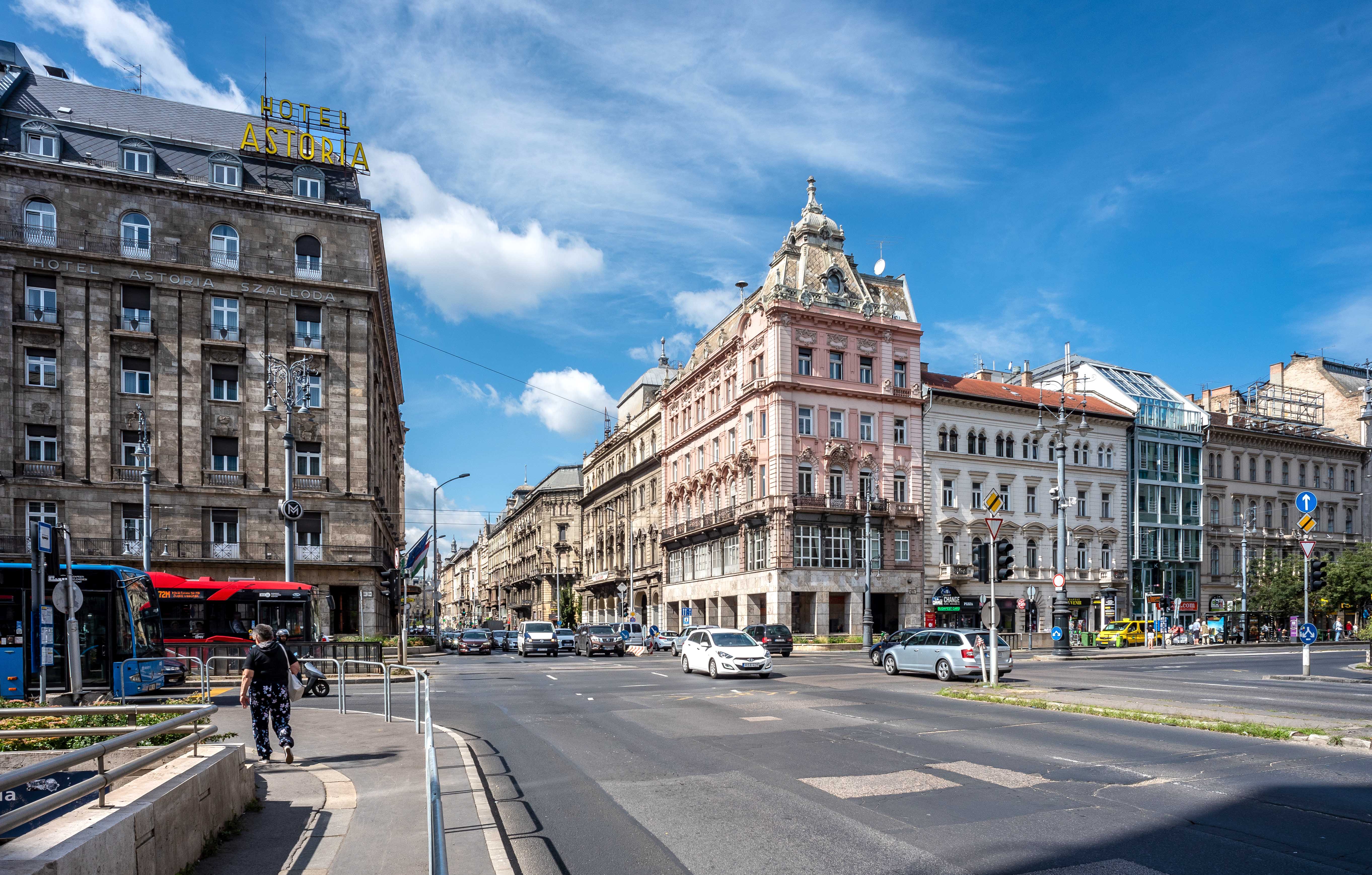
The picture above shows the demolition of downtown Pest: the widening of Hatvani, now Kossuth Lajos Street, was necessary due to the construction of the Erzsébet Bridge, at which time the Förstner-Schiefner House in the picture was also demolished. Below, the current state can be seen, the traffic of Kossuth Lajos Street rumbles on the site of the demolished building (Photo: Ország-Világ, 1 September 1895; Balázs Both/pestbuda.hu)
The construction of the Erzsébet Bridge required a huge sacrifice on the part of the city, the medieval core of Pest was practically demolished in order to widen the Hatvani (now Kossuth Lajos) Street. The corner of today's Astoria, next to the house at 22 Kossuth Lajos Street, the Förster-Schiefner House fell victim of the demolition. It was then owned by the Grünbaum and Weiner clothing store.
The interesting thing about the picture is that the past and the present can be seen on it at the same time, because on the right side, there is already the residential house that is still standing. It was handed over in 1894, and designed by Sándor Hauszmann, then Flóris Korbl and Kálmán Giergl. In front of that, there are the remains of the building on the site of which today the traffic of Kossuth Lajos Street rumbles towards the Danube.
%201896%20k%C3%B6r%C3%BCl.jpg)
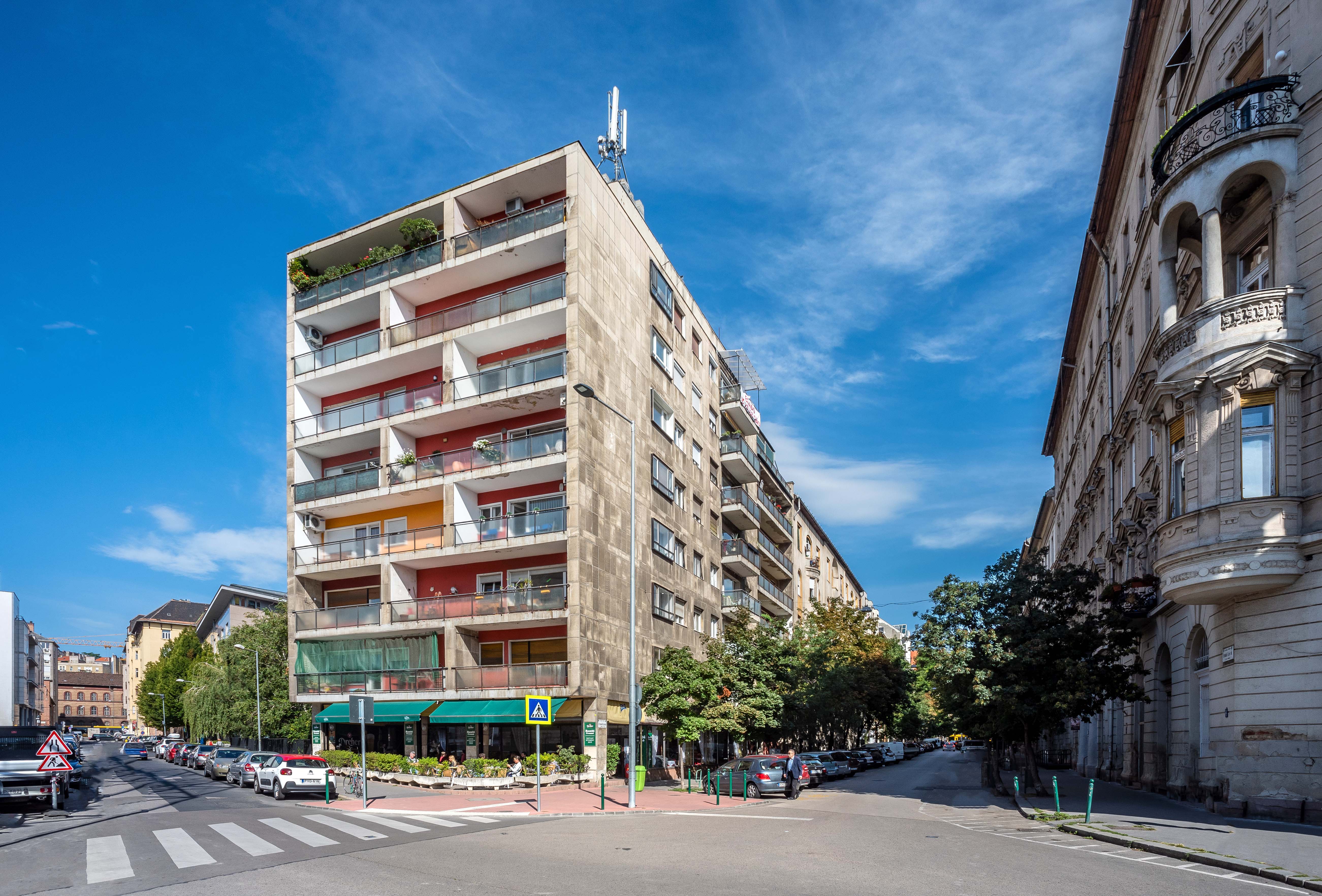 2-4 Frankel Leó Road around 1896 (above), where the tobacco shop of Manó Fanto was operating at the time the picture was taken. Below is the OTP House completed in 1959 (Photo: FSZEK Budapest Collection)
2-4 Frankel Leó Road around 1896 (above), where the tobacco shop of Manó Fanto was operating at the time the picture was taken. Below is the OTP House completed in 1959 (Photo: FSZEK Budapest Collection)
On the corner of Bem Square, on the side opposite Radetzky’s Barracks, which fell victim to investor interests, at 2-4 Frankel Leó Road, stands the OTP House, completed in 1959, with the cult Bambi café at the bottom. Before the war, however, there were several smaller houses on the site, including the one-story corner building pictured, with the Manó Fanto tobacco shop on the ground floor, as the sign advertises, alongside with Ede Bartl's file making workshop and Lajos Pápay's men's tailor shop. The trams running in front of the house lead to the Pálffy Remise in the background, which was still under construction, and was built in 1896, so the year can be concluded from this and the millennium exhibition poster on the wall of the house.
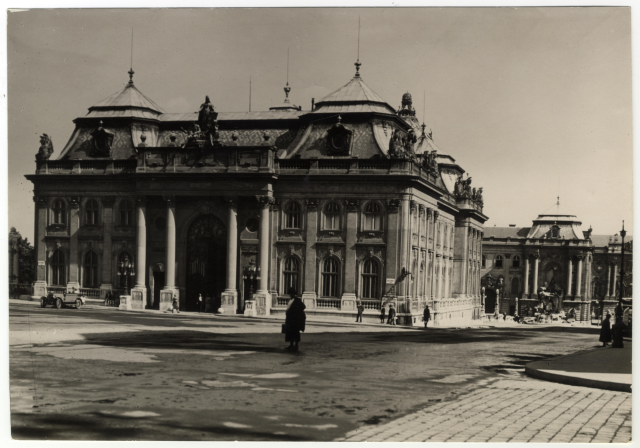
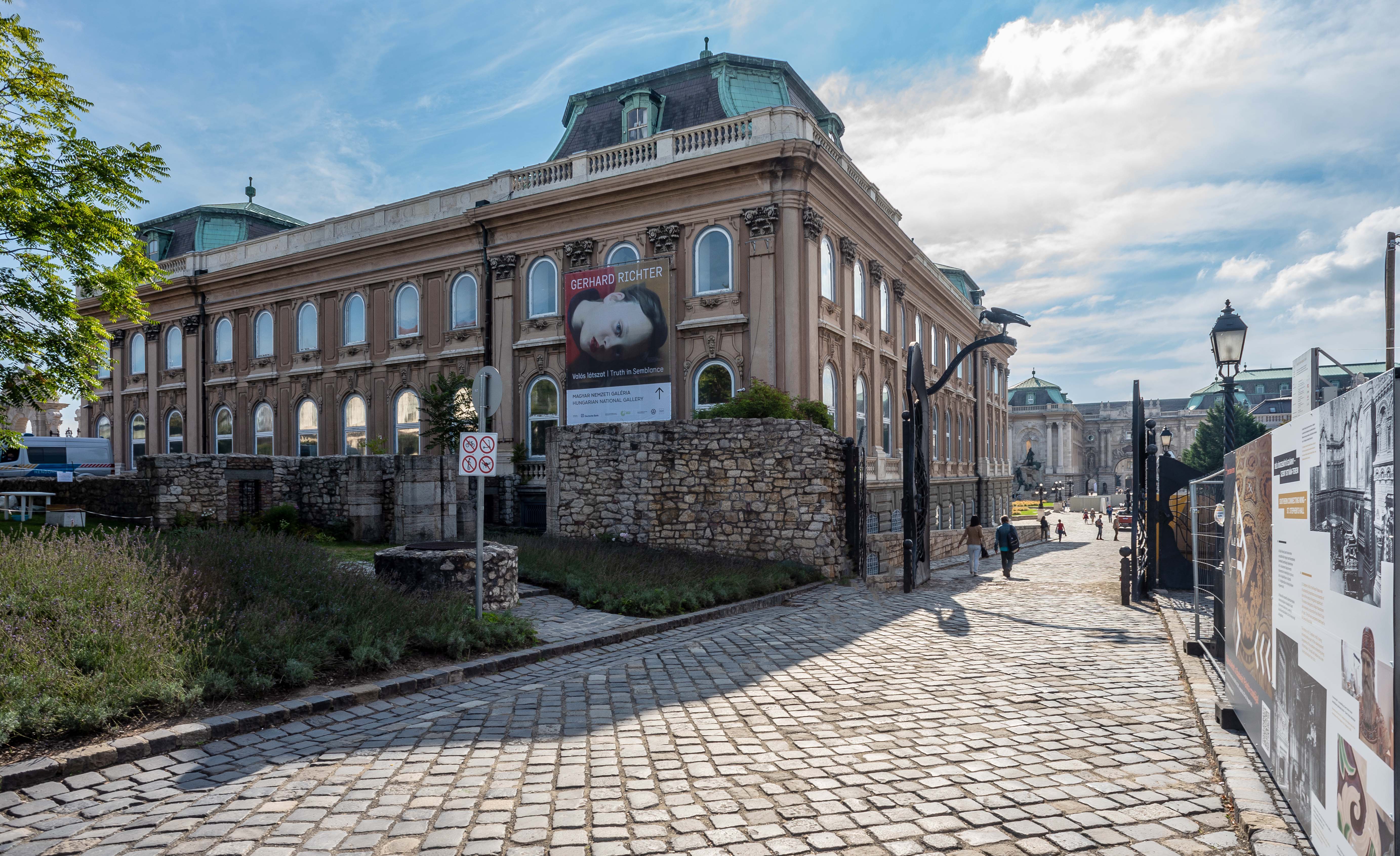
The original entrance of the Royal Palace of Buda from Szent György Square in the 1920s on the photo of Olga Máté, with the Mátyás Fountain in the background. Below is the current state, with a much wider and more unadorned facade (Photo: Hungarian National Museum Historical Photo Department; Balázs Both/pestbuda.hu)
If people had had things to do in the Buda Palace in the 1920s, when the picture above was taken, and they had looked for the main entrance, they would have found it in Szent György Square. Originally here, at the northern end of today's 'A' building designed by Alajos Hauszmann, it was possible to enter through a lavish lattice gate, made in the workshop of Gyula Jungfer, to one of the largest and most ornate royal palaces in Europe at the time.
The A-wing, built during the expansion of the Royal Palace, which was completed in 1904, served as the inn: the visitor could pass through a 200-metre-long row of halls from the main gate of Szent György Square. The building was badly but not irreparably damaged in World War II, but the communist power from 1947 opted for a radical transformation, the remaining interiors were destroyed, many walls were relocated, Building ‘A’ was extended westwards and the main entrance to Szent György Square was abolished. This is how the building gained its present form.
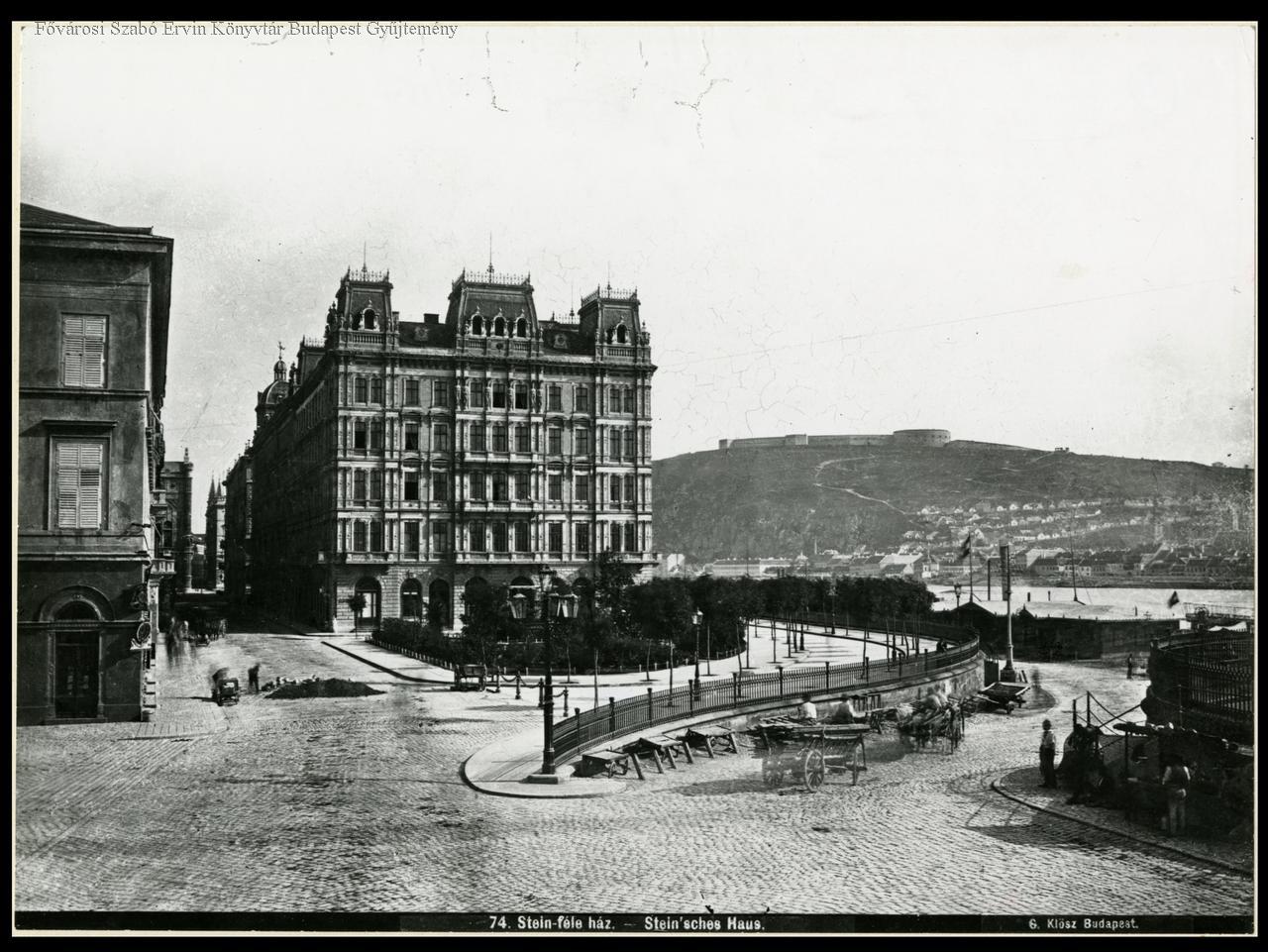
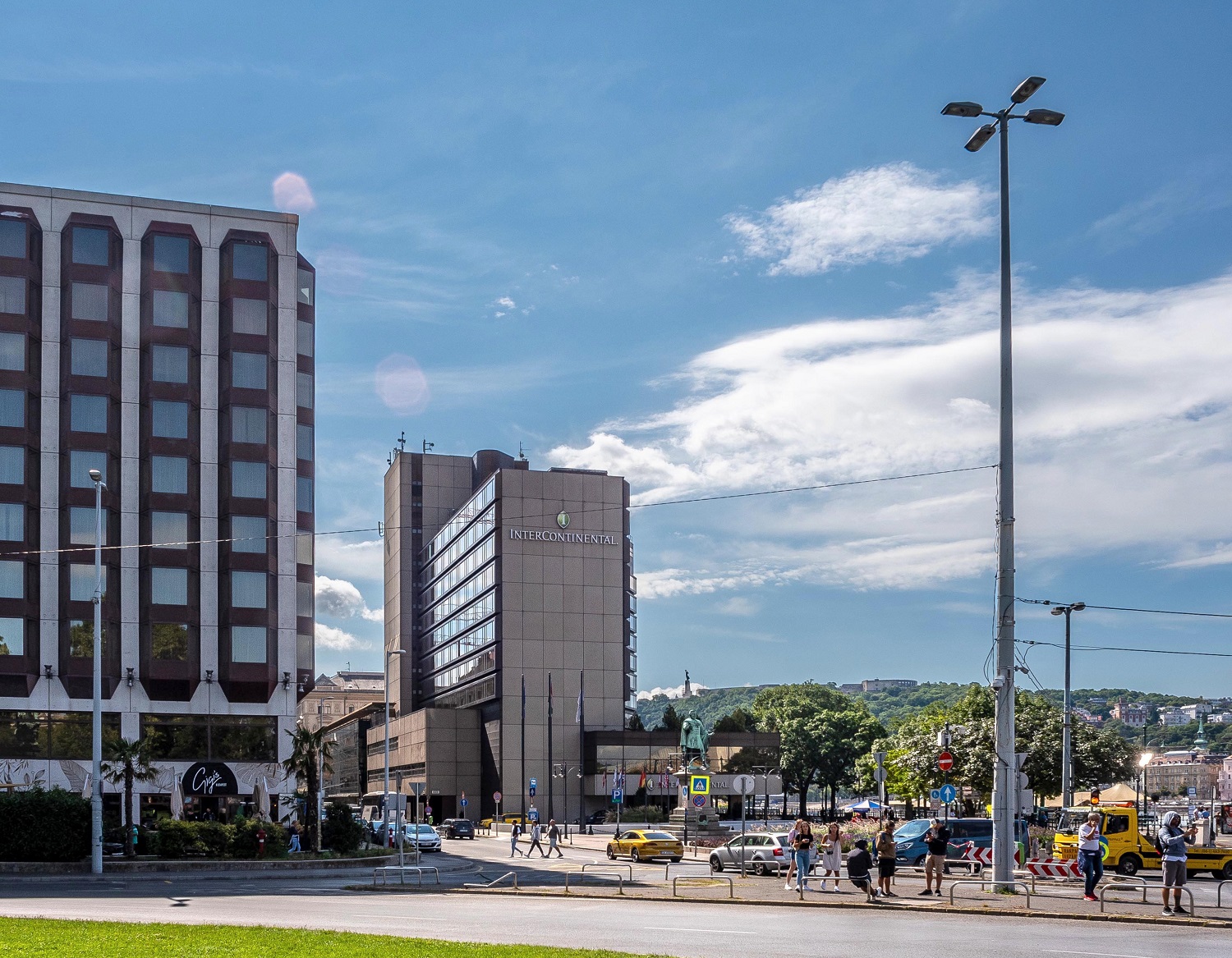
The photo of György Klösz, taken around 1875, shows the Stein House on the Danube Bank without the statue of József Eötvös erected in front of it in 1879 (above). The building has been the site of the former Fórum, now the Intercontinental Hotel since 1981 (Photo: FSZEK Budapest Collection)
Around 1875, when György Klösz took the picture above, the Stein House still stood, where today the first building of the Danube Bank hotel line, the Intercontinental, spreads. The pretty historicist building was built between 1869 and 1871 by Náthán Stein, but in 1891, it was already sold to the Hungarian-French Insurance Company, which four years later also passed it on. Finally, in 1909, it was transferred to the Ritz Hotel Chain, which demolished it the following year so that the Ritz Hotel building, later the Danube Palace, could be built on its site by 1913, according to Sándor Fellner's plans.
That was demolished after 1945, then the Fórum, today's the Intercontinental Hotel, was built on the plot in 1981. The left side of the picture also shows the corner of the legendary Lloyd's Palace, built for the headquarters of the Pest Civil Trade Board in Classicist style between 1827 and 1830 according to the plans of József Hild. It was demolished in 1948. There is still a hotel in its place today.
However, the statue of József Eötvös, the work of Adolf Huszár (his pedestal was made by Miklós Ybl) is missing from the picture, as it was erected only in 1879 in the small park in front of the Stein House. It was moved and placed a little further away in the 1980s due to hotel construction, but it still stands today.
Cover photo: The original main entrance of the Royal Palace of Buda from Szent György Square in the 1920s (Photo: Hungarian National Museum Historical Photo Department)

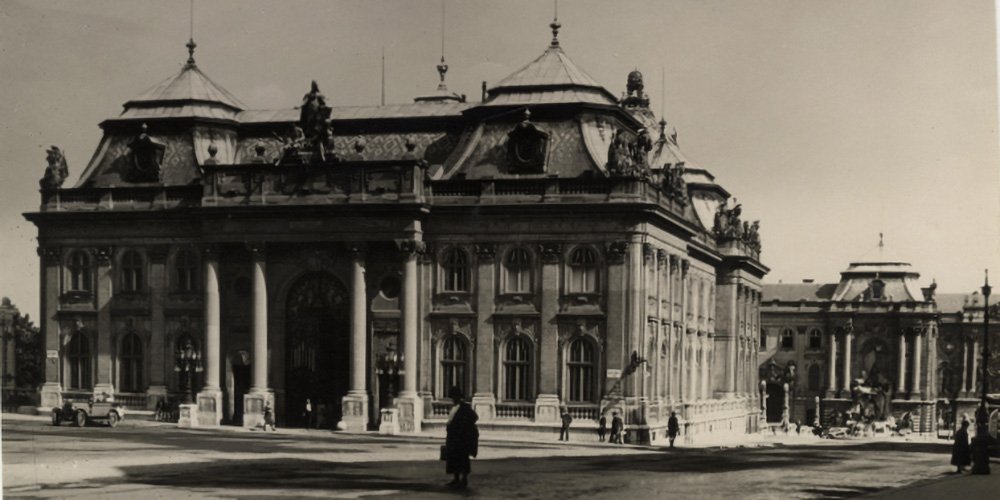


































Hozzászólások
Log in or register to comment!
Login Registration